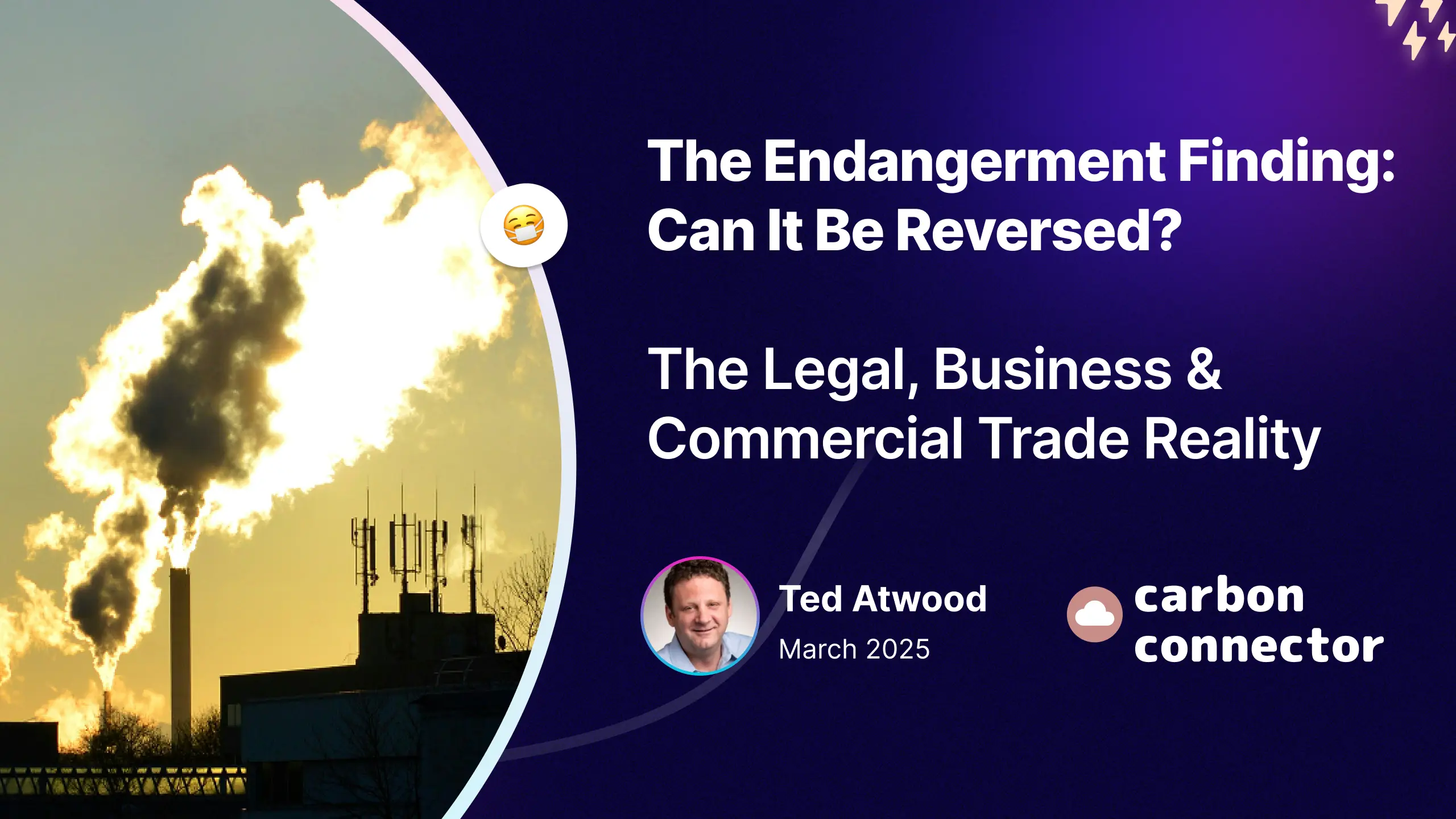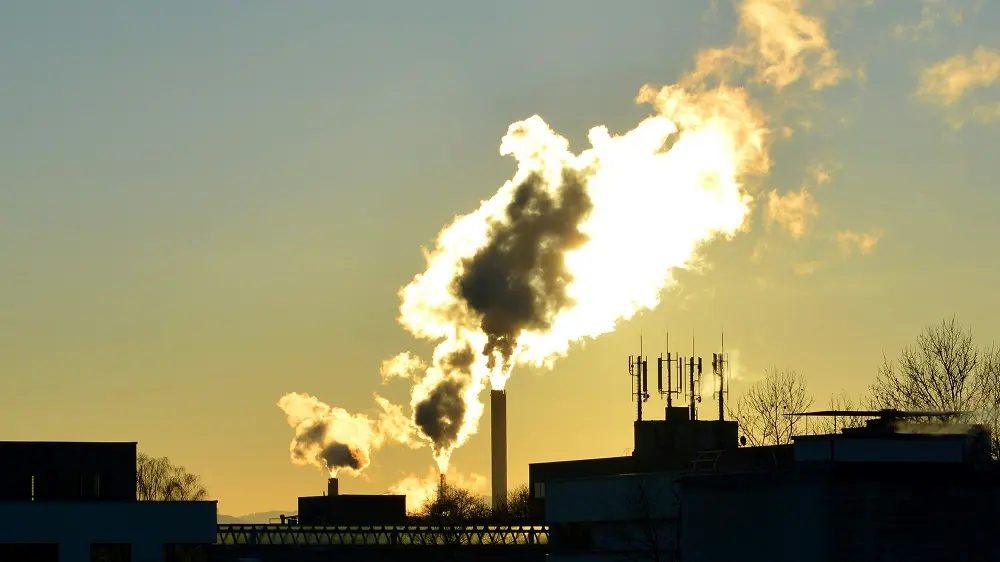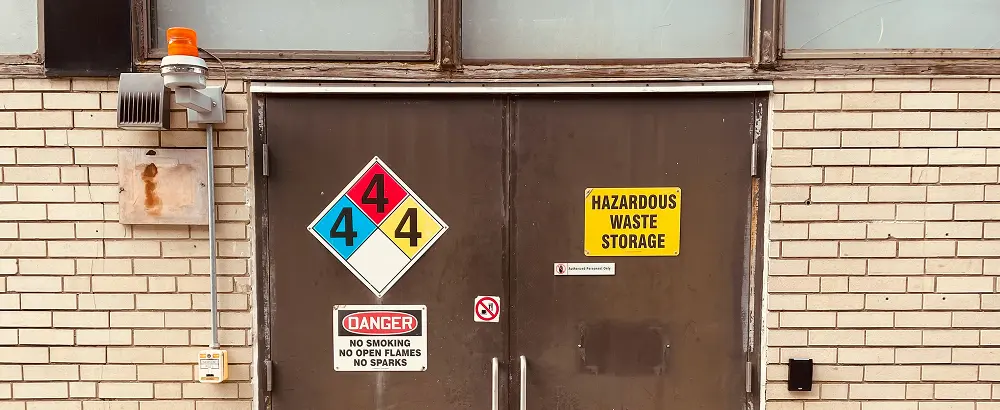
The Endangerment Finding: Can It Be Reversed?
The Legal, Business & Commercial Trade Reality
(Refrigerant Version)
On Wednesday, March 11, 2025, the EPA published 38 individual planned updates it undertook as part of its new leadership from Lee Zeldin, all under the auspices of a new type of activism inside the EPA called Cooperative Federalism.
This is not a word I chose or made up, but they referenced this new model of government in one of their releases Wednesday:
“The Biden Administration’s focus on ideological pursuits instead of the agency’s core mission and statutory duties resulted in a delay of air quality improvement. With more than 140 million Americans living in nonattainment areas around the country, cooperative federalism and clearing out the State Implementation Plan backlog will significantly improve the air we breathe,” said EPA Administrator Zeldin.
Project 2025, a policy roadmap published in April 2023 by The Heritage Foundation, advocates for shifting environmental regulatory authority from the federal government to state governments.
The document suggests that the EPA should adopt a supportive role, empowering state and local governments to lead environmental protection efforts rather than exercising centralized federal oversight. This aligns with the broader strategy of reducing federal regulatory control and increasing state-level autonomy in environmental policy enforcement.
Other relevant agencies are also involved in the EPA’s efforts to assess the legality and implications of reversing the endangerment finding, which is crucial for the regulation of greenhouse gases under the Clean Air Act.
Tell Congress to stop the EPA from destabilizing our regulatory system.
Find your representative, download our pre-drafted letter, and send it to urge Congress to support safety, business continuity, and trade stability.

Ironically, this new form of activism seeks to replace an older form of activism. However, the EPA’s actions regarding greenhouse gases (GHGs) were not voluntary but rather a legal obligation stemming from Massachusetts v. EPA. In this landmark case, the Supreme Court ruled that the EPA must regulate GHGs under the Clean Air Act if they are found to endanger public health and welfare. As a result, the agency was compelled to incorporate GHGs into its regulatory framework. I’ll let you know more about this later.
The debate around Project 2025’s push to “update” the 2009 Endangerment Finding isn’t just about climate policy—it’s about whether the U.S. government is even playing an active role in guiding industry anymore. Businesses that expect regulatory clarity are waiting for leadership that no longer exists.
As Adam Smith, the father of modern economics, wrote in The Wealth of Nations:
“The statesman, who should attempt to direct private people in what manner they ought to employ their capitals, would not only load himself with a most unnecessary attention but assume an authority which could safely be trusted to no council or senate whatever.”
Smith’s point? Markets will move on with or without government direction. And right now, the policy is in retraction mode, leaving companies to find their own path in an unstable regulatory environment.
So, if you’re waiting for clear rules, know that the rules are being rewritten every election cycle—especially with midterms on the horizon—and you’re on your own.
Brief History & Underpinnings of Massachusetts v. EPA (2007), the precursor to the Endangerment Finding
The landmark case of Massachusetts v. Environmental Protection Agency (EPA), decided by the U.S. Supreme Court in 2007, fundamentally changed the legal landscape for climate regulation in the United States.
What Led to the Case?
In 1999, a coalition of environmental groups petitioned the EPA to regulate carbon dioxide (CO₂) and other greenhouse gases (GHGs) from motor vehicles under the Clean Air Act (CAA). They argued that these gases contributed to climate change and air pollution, which the EPA was legally required to regulate.
The EPA under the Bush administration (2003) denied the petition, stating that:
- The Clean Air Act (CAA) did not explicitly classify GHGs as “air pollutants.”
- The agency lacked the authority to regulate GHGs for climate-related concerns.
- Even if it had the authority, the EPA claimed regulating GHGs would be unwise without further scientific certainty.
Similarly, the Trump administration’s efforts to roll back key regulations, such as the endangerment finding, were part of a broader opposition to climate science.
Tell Congress to stop the EPA from destabilizing our regulatory system.
Find your representative, download our pre-drafted letter, and send it to urge Congress to support safety, business continuity, and trade stability.

Who Sued & Why?
In Massachusetts v. EPA (2007), a coalition of 12 states, several cities, and environmental organizations sued the EPA, arguing that the agency had a legal obligation to regulate greenhouse gas (GHG) emissions under the Clean Air Act.
Their case was based on four key arguments:
Harm to States
Greenhouse gas emissions contribute to global warming, which leads to rising sea levels and environmental damage. Coastal states like Massachusetts argued that they were experiencing direct harm as a result.
EPA’s Duty Under the Clean Air Act
The Clean Air Act mandates that the EPA regulate pollutants that “may endanger public health or welfare.” The plaintiffs contended that GHGs met this criterion.
Failure to Act
By refusing to regulate GHGs, the EPA was failing to fulfill its statutory responsibility, allowing climate-related harms to continue unchecked.
State Authority Limitations
The plaintiffs also argued that individual states lacked the authority to regulate emissions from other states, leaving them vulnerable to the impacts of pollution beyond their borders.
A federal regulatory response was necessary because air pollution is not confined within state lines.
⚖️ Decision
The Supreme Court ruled in favor of Massachusetts, determining that GHGs qualify as pollutants under the Clean Air Act.
The decision compelled the EPA, in collaboration with relevant agencies such as the White House Budget Office and other federal bodies, to regulate GHG emissions if they were found to endanger public health and welfare, setting a legal precedent that continues to shape U.S. climate policy.
The Supreme Court Decision (2007)
The Court ruled in a 5-4 decision in favor of Massachusetts.
Key Findings:
Massachusetts Had Standing to Sue
The Court ruled that states have special standing in environmental cases since climate change directly affects their land and citizens.
GHGs Are Air Pollutants Under the Clean Air Act
The Court determined that CO₂ and other GHGs fit the definition of pollutants and could be regulated.
EPA Cannot Refuse to Regulate Without Scientific Basis
The Court ruled that the EPA must regulate GHGs if it finds that they endanger public health and welfare.
Federal Government’s Authority in Massachusetts v. EPA (2007)
One key constitutional and legal argument in Massachusetts v. EPA revolved around the federal government’s distinct authority to manage interstate trade and environmental policy under the Commerce Clause and the Clean Air Act (CAA).
1. The Federal Role in Managing Interstate Pollution & Trade
The plaintiffs (Massachusetts and other states) argued that GHG emissions from motor vehicles are a form of pollution that crosses state lines, making it a federal regulatory issue under the Commerce Clause of the U.S. Constitution.
- Because climate change does not stop at state borders, states individually lack the authority to regulate emissions from vehicles sold or driven across multiple states.
- The federal government has exclusive authority through the EPA to regulate pollutants that affect interstate commerce, including emissions from cars, trucks, and industrial facilities.
- Allowing the EPA to ignore GHG emissions would lead to a fragmented regulatory landscape, with states imposing inconsistent regulations that would disrupt interstate commerce. We had seen elements of this with acid rain in the 1980s.
The Supreme Court recognized this argument, reinforcing that federal agencies have the power—and sometimes the obligation—to regulate pollutants affecting the national economy and environment.
We are on a mission to redefine refrigerant leak detection.
2. The EPA’s Obligation Under the Clean Air Act
The Clean Air Act (CAA) grants the EPA the authority to regulate pollutants that “may endanger public health or welfare”. The plaintiffs argued that:
- The CAA’s broad definition of “pollutant” includes greenhouse gases.
- Congress gave the EPA a duty to regulate harmful emissions—not optional discretion.
- By refusing to act, the EPA was violating its statutory responsibility under the CAA.
The Supreme Court agreed with this interpretation, ruling that GHGs are pollutants under the Clean Air Act and that the EPA must regulate them unless it provides a scientific reason not to.
3. The Federal Government’s Precedent in Environmental Regulation
The case also reinforced that federal environmental regulation has long been upheld under the Commerce Clause, including:
- The Clean Air Act (1970) allows the EPA to regulate emissions from vehicles and industrial sources that affect air quality across state lines.
- The Clean Water Act (1972) prevents pollution in waterways that flow between multiple states.
- The Endangered Species Act, which protects biodiversity as part of the national economy.
By ruling in favor of Massachusetts, the Court reaffirmed that the federal government has apparent constitutional authority to regulate pollutants affecting interstate commerce—including GHGs from vehicles and industry.
Tell Congress to stop the EPA from destabilizing our regulatory system.
Find your representative, download our pre-drafted letter, and send it to urge Congress to support safety, business continuity, and trade stability.

Impact of the Decision on Greenhouse Gas Emissions
- In 2009, under the Obama administration, the EPA issued the Endangerment Finding, officially stating that GHGs threaten public health and welfare, forcing federal action.
- The ruling provided the legal foundation for climate regulations, including vehicle emissions standards, power plant regulations, and HFC phasedown policies under the AIM Act.
- Any future effort to reverse or weaken climate regulations must contend with this ruling.
Why This Case Matters Today
- The 2009 Endangerment Finding is directly tied to Massachusetts v. EPA.
If the EPA attempts to revoke or weaken it, they must either prove GHGs no longer endanger public health (which is scientifically difficult) or convince the courts to overturn the 2007 decision (which is highly unlikely). - Project 2025’s attempt to “update” the Endangerment Finding faces legal hurdles because the Supreme Court already ruled that GHGs are pollutants.
- Any rollback effort will trigger lawsuits, delaying or even preventing regulatory changes.
📌 Bottom Line
Massachusetts v. EPA cemented the EPA’s authority to regulate climate pollutants, and any attempt to reverse this will require fighting a settled Supreme Court precedent.
The Endangerment Finding and Climate Change
Establishing Greenhouse Gases as a Threat to Public Health and Welfare
The endangerment finding, issued by the Environmental Protection Agency (EPA) in 2009, established that greenhouse gases, including carbon dioxide, methane, and other climate-changing pollutants, pose a threat to public health and welfare.
This finding was based on overwhelming scientific evidence that these gases contribute to climate change, which in turn leads to a range of negative impacts on human health and the environment.
The EPA’s determination was upheld by the courts, including the D.C. Circuit Court of Appeals and the Supreme Court.

The Cornerstone of the EPA’s Authority to Regulate Emissions
The endangerment finding is the cornerstone of the EPA’s authority to regulate greenhouse gas emissions under the Clean Air Act.
The Act requires the EPA to limit the emissions of any air pollutant that, as determined by the agency, “causes or contributes to air pollution that may reasonably be anticipated to endanger public health or welfare.”
The endangerment finding provides the scientific and legal basis for the EPA’s regulations to cut greenhouse gas emissions from power plants, oil and gas operations, and other industries.
Tell Congress to stop the EPA from destabilizing our regulatory system.
Find your representative, download our pre-drafted letter, and send it to urge Congress to support safety, business continuity, and trade stability.
The Trump Administration’s Stance on Climate Change
Skepticism of Climate Change and Efforts to Roll Back Regulations
The Trump administration has been skeptical of climate change and has taken steps to roll back regulations aimed at reducing greenhouse gas emissions. In 2017, the administration announced its intention to withdraw from the Paris Agreement, an international accord aimed at mitigating climate change.
The administration has also taken steps to repeal or weaken several climate-related regulations, including the Clean Power Plan, which aimed to reduce greenhouse gas emissions from power plants.
EPA Administrator Lee Zeldin has been a vocal critic of climate change regulations, and the administration has sought to undermine the endangerment finding, which provides the scientific and legal basis for the EPA’s climate regulations.

Proposed Adjustments to the Endangerment Finding and EPCRA Reporting Responsibilities
The EPA’s planned review of the Endangerment Finding is a proposed adjustment, not an immediate policy change.
Any reclassification of greenhouse gases (GHGs) or related substances under the Clean Air Act would require a lengthy scientific review process, stakeholder engagement, and potential legal challenges.
Additionally, any significant regulatory rollback would likely face opposition from environmental groups, states, and possibly Congress through the Congressional Review Act (CRA). Implementing such changes could prove difficult given the current administration’s activist regulatory stance.
If these proposed adjustments move forward, they could eventually impact specific reporting responsibilities under the Emergency Planning and Community Right-to-Know Act (EPCRA) by altering how facilities track, report, and disclose emissions of climate-related substances.
Specific EPCRA Reporting Responsibilities Potentially Affected
While GHGs are not directly regulated under EPCRA, the EPA’s adjustments to the Endangerment Finding could indirectly influence certain pollutant classifications, impacting state and industry reporting obligations.
Key EPCRA sections that may be subject to change include:
1. Toxic Release Inventory (TRI) Reporting (Section 313)
- The TRI program requires facilities in specific industries to report annual releases and waste management activities for listed toxic chemicals.
- If the EPA’s review results in changes to GHG-related substances, it could alter TRI listing decisions, affecting chemicals such as Fluorinated gases (HFCs, HFOs, PFCs) used in refrigeration and air conditioning; methane, a potent GHG that is already partially regulated under Clean Air Act programs; CO₂-based refrigerants and industrial emissions, which could face changes in classification.
- If GHGs or related compounds are removed from TRI, facilities in industries like petrochemicals, refrigeration, and energy-intensive manufacturing would see reduced reporting obligations for certain emissions.
2. Hazardous Chemical Storage Reporting (Sections 311 & 312 – SDS & Tier II Reporting)
If GHG-related chemicals are reclassified or removed, facilities storing substances such as HFCs, CO₂-based refrigerants, and methane may see reduced or eliminated Tier II reporting obligations.
EPCRA requires facilities storing hazardous chemicals above certain thresholds to: Maintain Safety Data Sheets (SDS) for these chemicals. Submit Tier II reports annually to state and local emergency planners.
The EPA’s “List of Lists” includes substances subject to multiple regulatory frameworks, including EPCRA hazardous substances.
3. Emergency Release Notification (Section 304)
- Facilities must immediately notify state and local emergency responders if they release an extremely hazardous substance (EHS) above reportable thresholds.
- If the Endangerment Finding review leads to the removal or reclassification of certain high-GWP chemicals, facilities handling substances like HFCs, methane, or CO₂-based emissions may no longer be required to report emergency releases, limiting public and emergency response awareness of potentially hazardous emissions.

Impact on the EPA’s “List of Lists”
The EPA’s Consolidated “List of Lists” is a reference guide for substances regulated under:
✔ Toxic Release Inventory (TRI)
✔ Risk Management Program (RMP) under the Clean Air Act
✔ Emergency Planning and Community Right-to-Know (EPCRA) reporting
✔ Comprehensive Environmental Response, Compensation, and Liability Act (CERCLA) hazardous substances
If the EPA’s proposed Endangerment Finding review leads to deregulatory actions, potential changes to the List of Lists could include:
- Fluorinated gases (HFCs, HFOs, PFCs) being delisted or downgraded, reducing reporting requirements for refrigeration and industrial sectors.
- Methane being reclassified, potentially impacting oil & gas facilities and landfill emissions reporting.
- CO₂-based emissions losing regulatory oversight, limiting disclosure obligations for facilities using CO₂ refrigerants or engaging in carbon-intensive processes.
- State reporting programs weakening, as many state-level environmental regulations rely on federal pollutant classifications.
Tell Congress to stop the EPA from destabilizing our regulatory system.
Find your representative, download our pre-drafted letter, and send it to urge Congress to support safety, business continuity, and trade stability.
Stakeholder Group Size Affected by These Proposed Adjustments
The total number of affected stakeholders under these proposed changes is substantial, spanning multiple industries, regulatory agencies, and public interest groups. Some key impacted groups include:
- Industrial Facilities Required to Report Under EPCRA
- Refrigeration, HVAC, and Cold Chain Industries
- Oil & Gas, Manufacturing, and Chemical Processing
- State and Local Emergency Planning Committees (LEPCs & SERCs)
- Environmental and Public Health Advocacy Groups
Challenges to Implementing These Adjustments Under the Current Administration
Despite the proposed review, significant political, legal, and scientific hurdles stand in the way of substantive regulatory changes:
✔ Lengthy Scientific Review Process
Any modifications to the Endangerment Finding must undergo extensive scientific evaluation, requiring justification for changing the classification of GHGs as pollutants.
✔ Legal Challenges & Precedents
The Supreme Court’s ruling in Massachusetts v. EPA (2007) established that GHGs must be regulated under the Clean Air Act if they pose a risk to public health. Weakening or reversing this decision would require a substantial legal argument.
✔ Congressional Review Act (CRA) Opposition
Congress has the power to overturn major regulatory rollbacks via the CRA, especially if control of the legislature does not align with the administration’s deregulatory agenda.
✔ State-Level Pushback
Many states have adopted stricter climate policies than federal requirements. Even if federal rules are relaxed, states like California (via CARB), New York, and Washington will likely maintain GHG reporting mandates, creating a fragmented regulatory landscape.
We are on a mission to redefine refrigerant leak detection.
The Legal Complexity: You Can Change Enforcement, But You Can’t Change Precedent
The 2009 Endangerment Finding exists because of the 2007 Supreme Court ruling (Massachusetts v. EPA), which said that GHGs are pollutants under the Clean Air Act.
It took the EPA nearly two years to publish the court case results with Massachusetts. So any challenge to the Endangerment finding would result in lawsuits, a slowdown in the signage, and court action that will take years—many more years than the election cycle offers any administration to deploy changes.
All of the following challenge timelines will also meet resistance, and have to be promulgated under new regulations put in place by Congress during the last 16 years, making each of these more procedural and harder to accomplish.

Timeline for Legal Challenges & Election-Driven Political Shifts
Rulemaking Process (12-18 months)
Any effort to “update” or weaken the Endangerment Finding must go through a formal EPA rulemaking process under the Administrative Procedure Act (APA), requiring scientific justification, public comment periods, and regulatory review. This timeline extends well into 2026, meaning any proposed rule would likely not take effect before the next presidential election.
State Lawsuits (Immediately upon rule change)
States like California, New York, and Massachusetts will immediately challenge any attempt to weaken the Endangerment Finding, citing their own climate policies and the 2007 Supreme Court precedent (Massachusetts v. EPA). These lawsuits could result in injunctions, pausing any federal rollback while the courts review the case.
D.C. Circuit Court Review (2-3 years)
Legal challenges will likely land in the D.C. Circuit Court of Appeals, where prior cases have upheld climate-related EPA authority.
If a new administration attempts a rollback, expect this court to issue stays or block implementation. The case could take until 2027 or later to reach resolution—well into the next presidential cycle.
Supreme Court Decision (If It Gets That Far) (2028-2030)
If appealed, the case could reach the Supreme Court no earlier than 2028, with a ruling potentially coming just before or after the 2030 midterms—a full two election cycles from now. By then, the political landscape will likely have shifted again, influencing any final decision.
Lisa Heinzerling, Legal Scholar & Lead Counsel for Petitioners in the original case 2007:
“This case was not about the science of climate change. The science was clear. It was about whether our government would listen to it.”
Tell Congress to stop the EPA from destabilizing our regulatory system.
Find your representative, download our pre-drafted letter, and send it to urge Congress to support safety, business continuity, and trade stability.
Election-Driven Political Shifts & Additional Uncertainty
- 2024 Presidential Election
The administration changed in January 2025, with new leadership and reversed regulatory actions taken in 2024, adding further instability. - 2026 Midterms
If Congress flips, it could impact funding, legislative oversight, and legal defense strategies for either an aggressive or weakened EPA. - 2028 Presidential Election
If litigation remains unresolved, the next administration could either double down on regulatory rollbacks or reinforce the original Endangerment Finding. By 2028 we will only have 8 years until the 2036 refrigerant fluff.
The one constant is that we cannot rely on government because politics interferes with stability.
This means that election cycles will continuously disrupt any policy direction, and ongoing court cases will further complicate the implementation timeline.
No matter what Project 2025 advocates for, it is uninformed about the flexibility on this topic. The combination of legal challenges, multiple election cycles, and shifting congressional power means that regulations won’t disappear overnight.
“There are no solutions, only trade-offs.” Thomas Sowell
Every regulatory shift comes with winners and losers—businesses that anticipate and adapt will thrive, while those waiting for stability will fall behind.
➡️ For businesses
This means the safest strategy is to plan for continued long-term compliance rather than gamble on political swings.
Business Disruption: Regulatory Uncertainty, Safety Risks, and Trade Challenges
The EPA’s proposed adjustments to the Endangerment Finding and environmental reporting obligations will create massive regulatory uncertainty for businesses operating across multiple states. Instead of providing clarity, these changes will leave industries navigating a patchwork of inconsistent environmental regulations, disrupting risk management, safety planning, business continuity, and trade operations.
The global demand for environmentally friendly cooling solutions highlights the need for regulatory clarity to meet sustainability goals and address increasing environmental awareness.
This shift also contradicts foundational economic principles championed by Adam Smith, a seemingly significant figure in the Heritage Foundation’s economic philosophy—the same organization advocating for the rollback of federal environmental regulations under Project 2025.
Smith’s vision for fair trade and competitive markets required clear, consistent rules, ensuring that businesses could operate efficiently without arbitrary government interventions that distort commerce.
Yet, the EPA’s proposed shift undermines this principle by creating regulatory inconsistency, forcing industries to navigate an unpredictable mix of state-level laws, rather than a uniform national framework.
The consequences will be disruptive not only for businesses but for trade, investment, and public safety.
We are on a mission to redefine refrigerant leak detection.
1. Regulatory Uncertainty and the State-by-State Challenge
- The federal government’s decision to shift responsibility to the states contradicts the Supreme Court’s ruling in Massachusetts v. EPA, which recognized that states cannot effectively regulate emissions across state lines.
- If the EPA weakens federal oversight, businesses will be left to comply with a patchwork of state regulations, creating compliance chaos and legal uncertainty.
- Some states will maintain strict emissions reporting and enforcement, while others may weaken or eliminate requirements, forcing businesses to operate under multiple, conflicting regulatory frameworks.
- The result? Higher compliance costs, increased litigation risks, and operational inefficiencies for companies operating across multiple jurisdictions.
Even from a free-market standpoint, Adam Smith never advocated for disorder or fragmented oversight. His philosophy stressed that while markets must be free to operate, they require a level playing field to function effectively.
This piecemeal deregulation effort creates competitive imbalances where businesses in states with stricter environmental rules are penalized, while those in states with weaker regulations gain an artificial advantage—precisely the kind of market distortion Smith warned against.
2. Safety & Risk Management Challenges for Businesses and Communities
- The Emergency Planning and Community Right-to-Know Act (EPCRA) ensures first responders, local governments, and businesses have access to critical hazardous chemical data.
- If the EPA weakens reporting requirements, companies may no longer be required to disclose key hazardous materials, putting workers, emergency responders, and the public at risk.
- Facility operators and supply chain partners will face new liabilities, as insurance carriers, investors, and compliance officers struggle to assess regulatory risk in an unstable policy environment.
- Adam Smith’s economic principles also stressed the role of government in ensuring a stable marketplace. Without clear guidelines for risk management, businesses cannot confidently plan long-term investments, making capital allocation inefficient and supply chains more fragile.
This unpredictability is not pro-business—it is anti-competitive. Regulatory volatility does not free markets; it creates winners and losers based on arbitrary political shifts rather than economic merit.
3. Trade & Economic Disruptions from Regulatory Divergence
- International markets are moving toward stricter environmental and emissions regulations, while the U.S. is now considering a step backward.
- If the U.S. weakens its environmental oversight:
✔ States with stricter rules (e.g., California, New York, Washington) will impose their own, creating an unbalanced trade environment.
✔ Businesses could face difficulties meeting export standards in countries with stricter environmental policies.
✔ Companies operating in multiple states may face legal and financial barriers as they navigate differing compliance requirements.
Adam Smith argued that fair competition requires consistent regulatory standards. Without uniform environmental rules, businesses in different states face uneven compliance burdens, which distorts market outcomes and creates an unlevel playing field.
- Interstate supply chains will be disrupted, as companies working across multiple states struggle to determine which environmental regulations apply to which facilities and contracts.
- Financial markets and investors are already incorporating environmental risk into their investment decisions, and a lack of clear federal guidance could lead to capital flight from U.S. industries deemed too risky.
If the U.S. government continues to oscillate between regulatory expansion and contraction every election cycle, businesses will struggle to plan, invest, and remain competitive on a global scale.
Smith’s concept of natural order in trade required governments to create frameworks that allow commerce to flourish—not frameworks that change so frequently that they deter investment altogether. Unstable regulatory conditions discourage long-term business planning, making it harder for American companies to compete both domestically and globally.
Tell Congress to stop the EPA from destabilizing our regulatory system.
Find your representative, download our pre-drafted letter, and send it to urge Congress to support safety, business continuity, and trade stability.

4. The Posture Problem: Industry Must Prepare for Instability
Many companies think, “Let’s wait and see what happens.”
That’s not a viable strategy.
✔ Midterm elections will change political dynamics, meaning long-term uncertainty is guaranteed.
✔ The EPA may pull back, but states and global markets are moving forward, creating a fractured regulatory landscape.
✔ Lawsuits will inevitably follow any EPA rollback, creating delays and making long-term business planning nearly impossible.
🧠 Business Mindset
The correct business strategy is to assume uncertainty, build resilience, and operate with risk mitigation in mind.
What’s the right approach?
✔ Follow the strictest state-level regulations, because they will define future compliance standards.
✔ Build flexibility into business operations to accommodate shifting regulations.
✔ Expect legal battles and policy reversals, and plan accordingly.
Bottom Line
Businesses cannot wait for political cycles to determine their future.
Regulatory instability is now a permanent feature of the U.S. economy, and companies that fail to adapt will fall behind.
Final Thought: Deregulation Creates More Instability, Not Less
Adam Smith’s invisible hand of the market operates under stable rules, not under shifting, unpredictable political directives. The EPA’s decision to leave emissions regulation to the states contradicts both legal precedent and economic common sense, making it harder for businesses to plan, invest, and operate with confidence.
Smith wrote in The Wealth of Nations: “The statesman, who should attempt to direct private people in what manner they ought to employ their capitals, would not only load himself with a most unnecessary attention, but assume an authority which could safely be trusted to no council or senate whatever.”
His argument applies here—businesses need consistent, reliable regulations to operate efficiently. By removing federal oversight, the EPA is not eliminating regulation but rather forcing companies to comply with a fragmented and unstable system.
The absence of clear rules is just as damaging as excessive rules, and businesses will suffer from this self-imposed instability.
This raises a fundamental question for policymakers and industry leaders: If the goal is economic growth and business success, why introduce regulatory chaos into an uncertain global market?
Tell Congress to stop the EPA from destabilizing our regulatory system.
Find your representative, download our pre-drafted letter, and send it to urge Congress to support safety, business continuity, and trade stability.



